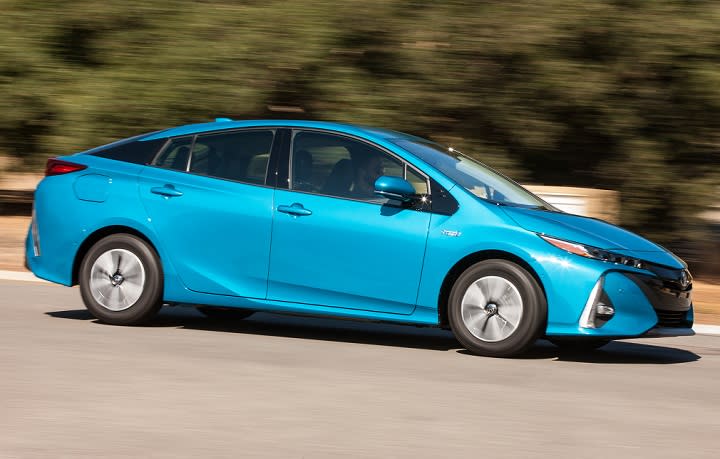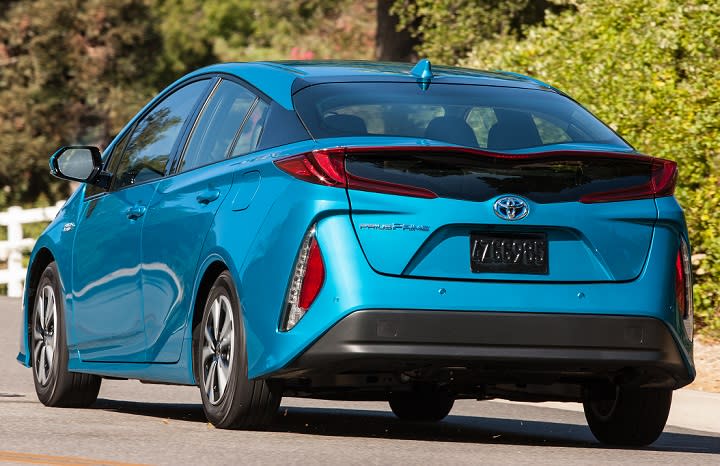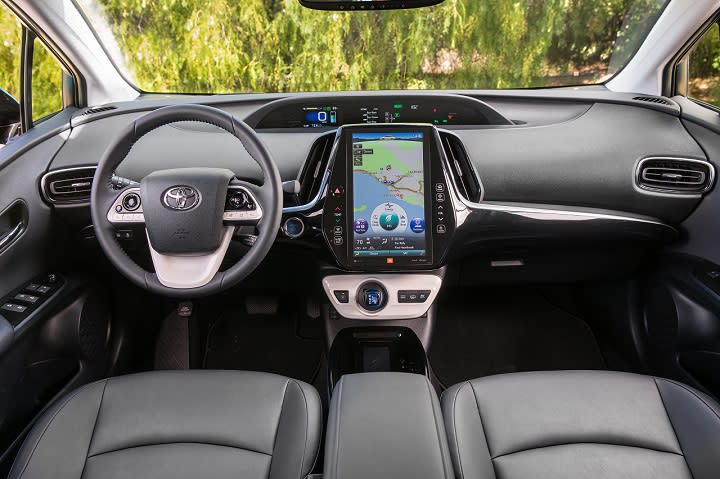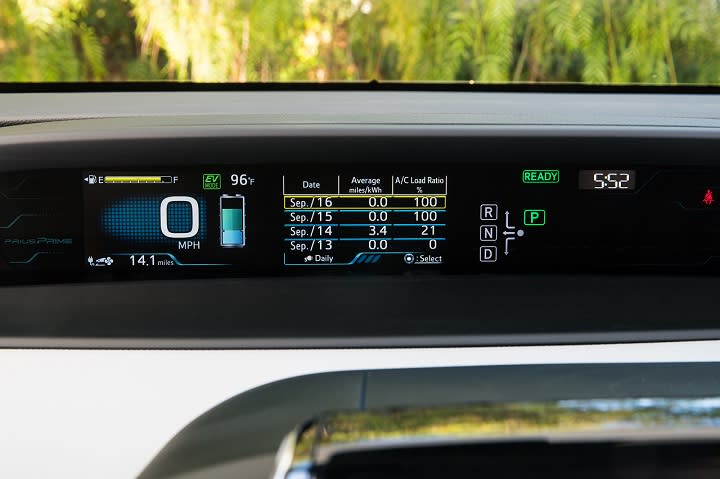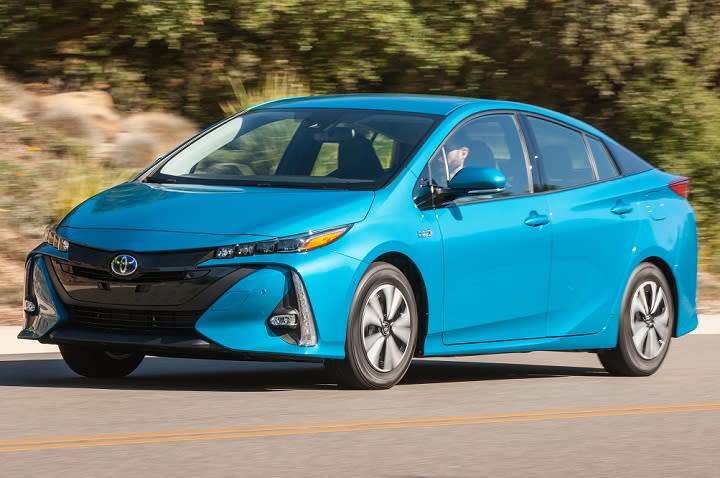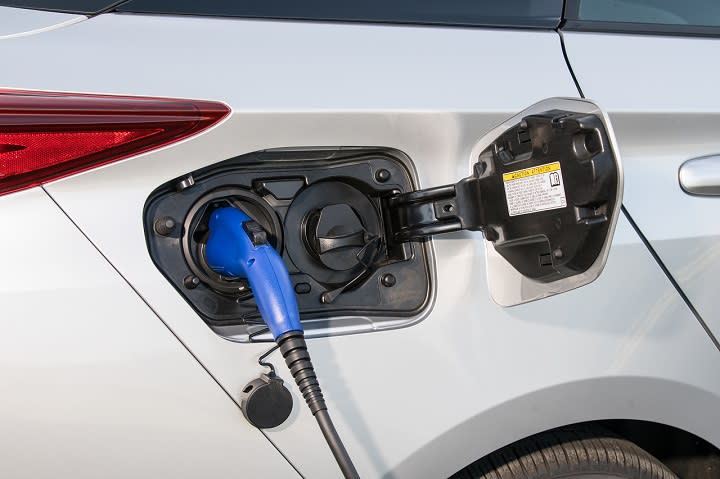Test Drive: 2017 Toyota Prius Prime
Body Style:
Abstract:
Defined as “of first importance” or “of the best possible quality,” the word “prime” is used to designate the new plug-in version of the Toyota Prius.
Year:
2 017
2017 Toyota Prius Prime Advanced front quarter right photo Introduction
Defined as “of first importance” or “of the best possible quality,” the word “prime” is used to designate the new plug-in version of the Toyota Prius.
Based on the redesigned Prius that debuted last year, the 4-passenger 2017 Toyota Prius Prime starts at $27,100 before factoring in a federal tax credit and state/local incentives, travels up to 25 miles on electricity, provides as much as 640 miles of total driving range, has a 19.8 cu. ft. trunk, and is available in all 50 states.
Equipped with different styling for a unique appearance whether it is day or night, the new 2017 Prius Prime remains a gas-electric hybrid, but its more powerful dual-motor electric drive system and larger, high-capacity Lithium-ion battery provide 25 miles of electric driving range before the gasoline engine kicks in, and the Prime can go as fast as 84 mph on pure battery power.
It takes 5.5 hours to recharge the car using a standard household outlet, and less than half that time using a 240-volt home or municipal charger. At home, owners can program the car to recharge during off-peak hours when electricity rates are lower. Pre-heating and pre-cooling the cabin is possible as long as the battery is charged to 22% capacity or greater.
Toyota also supplies a standard battery warming system for the Prius Prime, which works when the car is plugged in. That way, the car can start in electric mode right away rather than requiring the gasoline engine until the battery warms above freezing.
Briefly tested under sweltering conditions in Ojai, California, the Prius Prime didn’t need its battery warming system. Instead, its available SofTex leatherette seats needed a ventilation system.2017 Toyota Prius Prime Advanced rear quarter left photo Styling and Design
Toyota has restyled the Prius Prime in an effort to clearly differentiate the plug-in version of the car from the standard gas-electric Prius. They share a platform, architecture, and numerous body panels, but the Prime gets new front and rear detailing, different wheel covers, a “dual-wave” rear window, and a carbon-fiber hatchback.
With LED headlights adopted from the Toyota Mirai fuel-cell car, an acrylic overlay covering a unique grille pattern, and a new hood and fascia, the Prius Prime puts forth a pugnacious face. Is it an improvement over the standard Prius? That’s up to you to decide.
Around back, the Prime’s dual-wave rear glass is undeniably cool, and the horizontally oriented taillights give it a completely different look from a standard Prius, especially at night. Again, your own sense of aesthetics will help you decide whether the Prime is more appealing than a standard Prius.
Inside, dashboard changes accommodate the Prius Prime’s available 11.6-in. vertical infotainment display. Looking and working like an oversized tablet computer, this system resembles the technology offered in a Tesla or a Volvo. In Moonstone (light gray), the Prime’s two-tone cabin treatment exudes a minimalistic, architectural, high-tech appearance.2017 Toyota Prius Prime Advanced interior photo Comfort and Controls
Toyota offers the Prius Prime in Plus, Premium, and Advanced trim levels. Cloth seats are standard for the Plus and Premium, while the Advanced version has SofTex leatherette upholstery. The test car was the Advanced trim level.
Comfortable and supportive, the driver’s seat provides a good view out. However, on hot days the SofTex leatherette does not breathe well, underscoring a need for perforations in the material and a front-seat ventilation system. Unlike the driver’s seat, the front passenger’s seat lacks a height adjustment function. However, it is mounted high enough off the floor that this omission isn’t an issue.
Two people can fit into the Prius Prime’s rear seat, sitting on individual chairs separated by a center console with a storage area. The Prime’s larger battery necessitates this design. Space is generous, though, allowing four tall adults to travel in comfort.
Toyota says the Prius Prime’s trunk holds 19.8 cu. ft. of cargo stacked to the glass, which represents a 7.6 cu. ft. loss of capacity. The company does not provide a measurement with the rear seats folded down, but it should be on par with a typical compact crossover SUV. When maximizing cargo space, the Prime’s trunk floor is uneven due to the car’s unique drivetrain.
Toyota’s new 11.6 in. vertical infotainment system looks good and functions decently. Using the voice-recognition system to program a destination was easy, and the available JBL sound system delivers an enjoyable music listening experience.
Often, however, when attempting to use one of the touch screen’s virtual buttons while the car traversed a bump, I’d touch the wrong thing and then need to reset the screen by choosing Home. I also think the primary function buttons that flank the sides of the screen ought to be switched: Home, Menu, and Stereo controls should swap to the left side of the screen and the hazard button and climate functions should be moved to the right. I was reaching far more often for the former than I was the latter.
A head-up display is also available for the Prius Prime, but if you wear polarized sunglasses it washes out to the point that you can’t even see a ghost of it.2017 Toyota Prius Prime Advanced instrument cluster photo Safety and Technology
In addition to 8 air bags, Toyota Safety Sense is standard for every Prius Prime, equipping the car with a forward-collision warning system with pedestrian detection, automatic emergency braking, and a lane-departure warning system with lane-keeping assist. A vehicle-sway warning system is essentially a drowsy driver monitor, and when it activates it displays a coffee cup within the car’s instrumentation.
Advanced trim adds a blind-spot monitoring system with rear cross-traffic alert, as well as Safety Connect services with a free 3-year trial period. Safety Connect provides automatic collision notification, emergency SOS assistance, and more—though it doesn’t have any safe teen driver functions such as speed, curfew, and boundary alerts. Safety Connect is also reserved for the Advanced trim level, meaning it is offered only on the most expensive version of the car.
Navigation is included for all Prius Prime trim levels, but the Premium and Advanced trim levels are exclusively available with the 11.6 in. infotainment display, which supports fingertip navigation map zooming and spreading, as well as swiping actions. One benefit of this screen size is that the navigation map is always on display in addition to other information.
Siri functionality is included for all Prime trim levels, but Toyota doesn’t offer Apple CarPlay or Android Auto smartphone-projection systems due to privacy concerns. Toyota claims that it will consider adding the technology in the future if its customers tell the company they want it.
Qi-compatible wireless charging is available for the Prius Prime, and the Prime Apps feature supplies remote charge management, remote climate management, a charging station map, dashboard showing the car’s ecological performance over time, and a vehicle-finder function.
An Intelligent Drive Coach adds assisted deceleration to the Prius Prime. This technology prompts the driver to maximize efficiency by “learning” the owner’s commute and stopping points and then automatically coasting the car as it approaches those stopping points.
Intelligent parking assist is also offered for the Prius Prime, an autonomous steering system that parks the car in parallel and perpendicular spaces while the driver operates the pedals and transmission. Intelligent clearance sonar helps to judge distance on the sides of the car.2017 Toyota Prius Prime Advanced front quarter left photo Driving Impressions
Though the Prius Prime is 300 pounds heavier than a standard Prius, and though it makes the same 121 combined horsepower, it still feels responsive. In fact, considering that I had not yet driven the redesigned Prius, the Prius Prime proved somewhat of a revelation. Based on Toyota’s new global vehicle architecture with an independent rear suspension and lower center of gravity, the new Prius feels lighter and more nimble, demonstrating greater responsiveness and improved dynamism.
In electric mode, the Prius Prime is quick and quiet. The car traveled just over 20 miles on a fully charged battery, but that included several aggressive acceleration runs along with lots of all-systems-go idling while my driving partner changed camera mount settings on the car.
Once we had drained the battery, the Prius Prime effortlessly returned 47.1 mpg on a loop with freeway, city, and highway driving. During the trip, we cycled between the car’s Eco, Normal, and Power driving modes, and while our result is less than the EPA’s combined rating of 54 mpg, it easily eclipses the result I would get in the previous-generation Prius.
The Prius Prime is equipped with EV, EV Auto, and HV (hybrid) driving modes. While using EV mode I accelerated to pass a slower truck on a slight incline in the road. With the accelerator plastered to the floor, I could not gain nearly enough speed to get around the truck in a safe manner. And this is exactly why the Prius Prime has an EV Auto driving mode, which automatically activates the gasoline engine when extra oomph is necessary.
Once the battery reaches its minimum state of charge and the car switches over to HV mode, the grumbling of the gasoline 4-cylinder engine is evident. Eco mode dulls the car’s responsiveness, while Sport mode noticeably quickens throttle response.
Steering is light in terms of effort, but is reasonably quick to respond and proves accurate, making the Prius Prime easy to hustle around corners. Suspension tuning provides a soft, wafting, bounding ride quality but controls roll to a remarkable and unexpected degree. The low-rolling-resistance tires supply decent grip, but resort to understeer at relatively low speeds.
On the highway, road noise is evident, as is some wind noise. Compared with the previous-generation Prius, the car’s brake pedal feels better than ever underfoot, with just a hint of the grabbing common to regenerative-braking systems. We needed to execute a very fast stop from a fairly high rate of speed, and it was easy to modulate the brakes right on the precipice of anti-lock braking engagement.2017 Toyota Prius Prime Premium charging port photo Conclusion
Naturally, Toyota is sensitive to comparisons with the Chevrolet Volt, which offers double the EV range in similar packaging. In defense of the Prime’s modest capabilities, Toyota offered this analogy: When you go for a run you don’t carry a gallon jug of Gatorade.
Toyota notes that the starting price for the Prius Prime is more than $6,000 less than the Volt, and that’s before applying up to $6,500 in tax credits and other incentives. Do your homework and you’ll discover that the Volt remains eligible for up to $7,500 in a federal tax credit. Still, even when leveraging every credit and government incentive, the Volt remains a little more expensive and a lot smaller inside.
Furthermore, Toyota says that if (and that’s a big “if”) you can recharge the car at work, the Prius Prime supplies enough driving range to cover 80% of American commutes. Plus, when the gasoline engine is used, the Prius Prime gets better fuel economy than the Volt.
No doubt, the Prius Prime has a battle on its hands. Styling could work in its favor, though. Whereas the Volt looks almost exactly like a Chevy Cruze inside and out, rendering it somewhat invisible on the road and not particularly special to drive, the more dramatic Prius Prime looks like an angry version of the already polarizing Prius.
Climb inside and it is instantly clear that you are sitting inside of a special car and not a rental car, one that can easily accommodate three friends and a decent amount of luggage. Add the Tesla-esque infotainment system and remarkably satisfying driving dynamics and Toyota has a compelling story to tell.
Additional Research:
Check this if this is NOT an Articles Listing Page:
New or Used:
New
Display Article Date?:
Fuel:
Article Is Flipbook:
Yes

 Yahoo Autos
Yahoo Autos 
